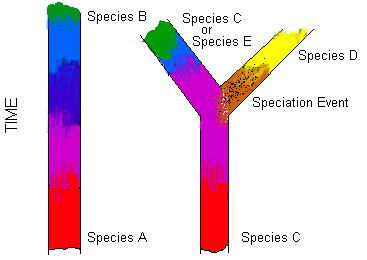

What's this? An ancestor and its descendant both in the fossil record at the same time? How could this be? Confusion is common between two different aspects of evolution: anagenesis and cladogenesis. Fancy words, but the concepts are simple when you realize two different processes are going on. In anagenesis, a single group changes through time, eventually becoming so different as to have to receive a new name. In cladogenesis, a single group splits into two separate groups, a process we also call speciation.
Where change is within a single group through geologic time, obviously the ancestral species and the later species cannot exist at the same time. But when a new species has split off of a parent species, both of them may continue to exist. Thus an ancestral species, though of course not the ancestral individuals, can occur contemporaneously with its offspring. As an analogy, we don't find it at all strange that those ancestors of ours whom we call our parents survive along with us. Just substitute "species" for "parents and us", and you've got it.

Contributor: Arthur H. Harris, Laboratory for Environmental Biology, Centennial Museum, University of Texas at El Paso.
Desert Diary is a joint production of the Centennial Museum and KTEP National Public Radio at the University of Texas at El Paso.

A simple diagram to demonstrate the difference between anagenesis (left) and cladogenesis (right). The colors represent changes in characters through time. In the left figure, Species A has changed so much that by the end of the segment (green) it has to be recognized as a different species (Species B). In the right-hand figure, anagenesis is taking place within the lineages, but the population splits into two separate species at the speciation event (cladogenesis); from that point, the right branch is a new species (Species D); Species C continues on (contemporaneous with it's "offspring" Species D); if at the terminal end, the green represents a sufficiently large difference from the original Species C (red), it would then become Species E.
Strickberger, M. W. 1996. Evolution. 2nd Ed., Jones and Bartlett Publishers, Sudbury, MA. 670 pp.